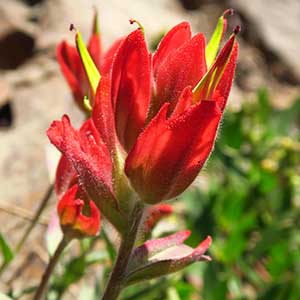Castilleja chromosa
Castilleja elmeri
desert paintbrush
Elmer's Indian paintbrush, Elmer's paintbrush, Wenatchee Indian paintbrush, Wenatchee paintbrush
several to many, ascending to erect, often grayish, unbranched, rarely branched, sometimes with short, leafy axillary branches, hairs spreading-erect, long, stiff, eglandular, sometimes also with shorter, stipitate-glandular ones.
solitary or few to many, erect to ascending, sometimes slightly curved at base, unbranched, rarely branched, hairs moderately dense, spreading, medium length, soft, mixed with shorter eglandular and stipitate-glandular ones, at least on distal 1/2 of stem.
gray-green, linear, lanceolate, or oblanceolate, sometimes broadly lanceolate, (1.5–)2.5–6(–7) cm, not fleshy, margins plane, involute, (0–)3–5(–7)-lobed, sometimes with secondary lobes, apex acuminate to obtuse;
lobes spreading, linear, apex acuminate.
green, rarely purple-tinged, linear-lanceolate, sometimes linear or lanceolate, 1.3–6.5 cm, not fleshy, margins plane, flat or involute, entire, apex acute.
2.5–15 (much longer in fruit) × 1.5–5.5 cm;
bracts proximally greenish to dull purplish, distally bright red to scarlet or orange-red, rarely yellowish to dull orange or pink, narrowly to broadly linear or lanceolate, narrowly ovate, or oblong-lanceolate, (0–)3–7-lobed, rarely with secondary lobes;
lobes spreading, linear to oblong, sometimes oblanceolate, often expanded near tip, long, proximal lobes arising below mid length, apex rounded or obtuse to sometimes acute.
2.5–9 × 1.5–3 cm;
bracts red, crimson, scarlet, pink, magenta, red-orange, burnt orange, orange, pale yellow, or whitish throughout, or proximally greenish, distally as stated above, oblong, narrowly obovate, elliptic-oblong, or narrowly ovate, 0(–5)-lobed, rarely with 1 or 2 pairs of short, usually distal lobes;
lobes ascending, lanceolate, very short, arising from distal edge, apex rounded to obtuse.
0 mm.
straight or ± curved, 18–35(–40) mm;
tube 8–15 mm;
beak short- or long-exserted, adaxially green to yellow-green, (9–)10–18 mm;
abaxial lip deep green, reduced, thickened, included to exserted, 2–3 mm, ca. 20% as long as beak;
teeth incurved, deep green, 0.5–1 mm.
straight, 20–33 mm;
tubes 13–18 mm;
beak, and sometimes abaxial lip, partially to fully exserted;
beak adaxially green to yellowish, 8–15 mm;
abaxial lip incurved, green, thickened, 2–3 mm, 20–33% as long as beak;
teeth ascending or incurved, green, 0.5–1 mm.
colored as bracts, sometimes with broad yellow band below colored lobe apices, (17–)20–27 mm;
abaxial clefts 4–10 mm, adaxial 6–12 mm, abaxial ca. 30% of calyx length, adaxial ca. 40% of calyx length, deeper than laterals, lateral 1–4 mm, ca. 15% of calyx length;
lobes oblong or ovate to narrowly triangular or lanceolate, apex obtuse to rounded.
proximally green to pale green, distally colored as bracts, 15–25 mm;
abaxial and adaxial clefts 5–14 mm, 33–50% of calyx length, deeper than laterals, lateral 1–4 mm, 6–20% of calyx length;
lobes lanceolate to narrowly triangular, apex rounded to obtuse.
= 24, 48.
= 48.
Castilleja chromosa
Castilleja elmeri
Castilleja chromosa is sometimes confused with 3b. C. angustifolia var. dubia (see discussion there). Castilleja chromosa retains its distinctive morphology across its wide range and is a characteristic species of much of the southwestern United States. Where it overlaps with C. angustifolia, the two are distinguished by inflorescence color and width and by the lengths of the calyx, corolla, and corolla beak. In the broad region of their sympatry, there is little evidence of intergradation, except in a few sites in Elko County, Nevada, and in southern Wyoming. Throughout southern Idaho and northeastern Nevada the range of the two overlap with little or no intergradation. At high elevations in Montrose County, Colorado, C. chromosa has narrower leaves and a longer and silkier pubescence, especially in the inflorescence. Apparent hybrids between C. chromosa and C. flava var. rustica are known from Custer County, Idaho, and hybrids with C. linariifolia are known from Montrose County, Colorado.
(Discussion copyrighted by Flora of North America; reprinted with permission.)
The bracts and inflorescences of Castilleja elmeri can be red, crimson, scarlet, pink, magenta, red-orange, burnt orange, orange, pale yellow, or whitish. While the coloration is highly variable between local populations, it is usually uniform and consistent within them. It is found primarily in the Wenatchee Mountains of Washington, where it is often on serpentine, but it ranges northward in the Cascades into extreme southern British Columbia, apparently on non-serpentine substrates. Hybrids with C. miniata var. miniata, C. parviflora var. albida, and C. thompsonii have been found in the eastern Cascades of Washington, and a similar hybrid swarm with C. thompsonii is reported from southern British Columbia.
(Discussion copyrighted by Flora of North America; reprinted with permission.)


